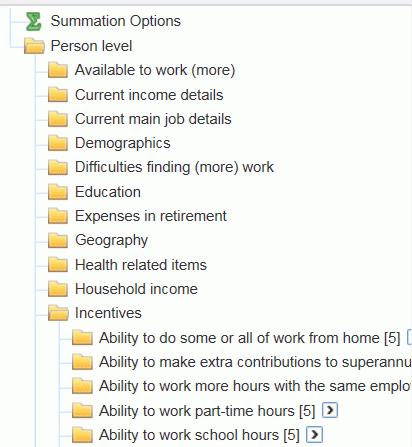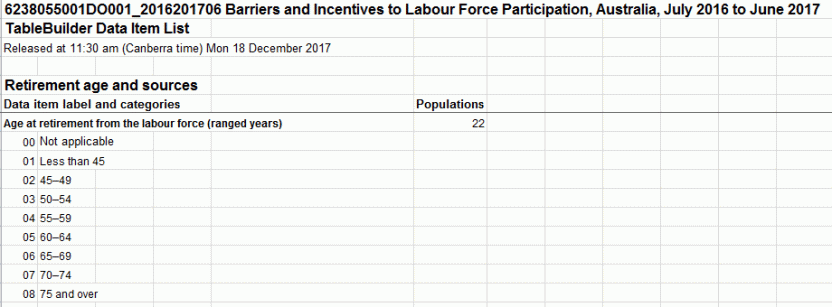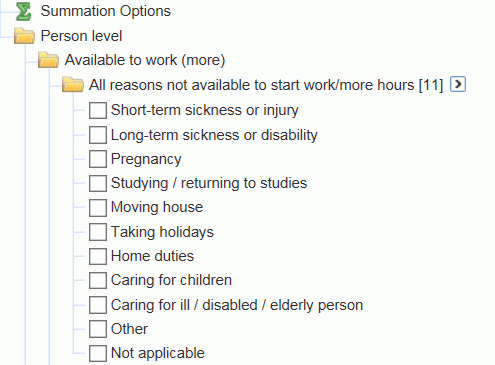TableBuilder: Barriers and Incentives to Labour Force Participation, Retirement and Retirement Intentions, Australia
Enables detailed analysis of retirement trends and the factors that influence people to work more
Barriers and Incentives to Labour Force Participation microdata in DataLab
Barriers and Incentives to Labour Force Participation microdata for 2014-15 to 2020-21 is now available in ABS DataLab, released as a supplementary file for the Longitudinal Labour Force (LLFS) microdata. All existing users of the LLFS microdata will automatically get access to the additional file (use of the file may require an updated project proposal) and new users can apply for access to both files.
A detailed data item list is available in Microdata and TableBuilder: Barriers and Incentives to Labour Force Participation
Related microdata from the annual Participation, Job Search and Mobility survey is also available for the period February 2015 to February 2022. For more information, refer to Microdata and TableBuilder: Participation, Job Search and Mobility.
Barriers and Incentives to Labour Force Participation in Tablebuilder
The release of the 2020-21 Barriers and Incentives to Labour Force Participation microdata into Tablebuilder has been delayed until later in the year due to the release of the 2021 Census data in Tablebuilder. The previously released and unrevised issues of Barriers and Incentives to Labour Force Participation, Retirement and Retirement Intentions in Tablebuilder for the periods 2010-11, 2016-17, and 2018-19 will remain available during this time.
Introduction
This product provides a range of information about the release of microdata 2018-19 Barriers and Incentives to Labour Force Participation, Retirement and Retirement Intentions (B&I and R&RI), including details about the survey methodology and how to use the microdata product; TableBuilder. A data item list and information on the conditions of use and the quality of the microdata are also provided. TableBuilder is an online tool for creating tables and graphs.
Microdata are the most detailed information available from a survey and are generally the responses to individual questions on the questionnaire or data derived from two or more questions.
The B&I and R&RI survey was conducted throughout Australia during the 2018-19 financial year and is designed to provide detailed information on characteristics of people who are not participating, or not participating fully, in the labour force and the factors that influence them to join or leave the labour force, and on information on retirement trends, the factors which influence decisions to retire, and the income arrangements that retirees and potential retirees have made to provide for their retirement.
Further information about this product, and other information to assist users in understanding and accessing microdata in general, is available from the Microdata Entry Page. Before applying for access, users should read and familiarise themselves with the information contained in the TableBuilder, User Guide.
Barriers and Incentives to Labour Force Participation - August 28, 2020
Data from the Barriers and Incentives to Labour Force Participation survey has now been included in this TableBulder product, coinciding with the publication of Barriers and Incentives to Labour Force Participation, Australia (cat. no. 6239.0).
Applying for access
To apply for access to TableBuilder, register and apply in Microdata Entry Page.
Further information on access steps can be found in How to Apply for Microdata on the ABS website.
Further information
Further information about the survey and the microdata can be found in the various pages associated with this product, including:
- A detailed list of data items for the Barriers and Incentives to Labour Force Participation and Retirement and Retirement Intentions TableBuilder, available in the Data downloads section.
Support
For further support in the use of this product, please contact Microdata Access Strategies on 1300 135 070 or via microdata.access@abs.gov.au.
Data available on request
Data collected in the survey but not included in TableBuilder may be available from the ABS, on request, as statistics in tabulated form.
Subject to confidentiality and sampling variability constraints, special tabulations can be produced incorporating data items, populations and geographic areas selected to meet individual requirements. These are available, on request, on a fee for service basis. For more information, contact the ABS by visiting www.abs.gov.au/about/contact-us.
Privacy
The ABS Privacy Policy outlines how the ABS handles any personal information that you provide to us.
Changes this issue
Weighting and estimation
From this issue, the Retirement and Retirement Intentions survey (R&RI) and Barriers and Incentives to Labour Force Participation survey (B&I) were weighted to benchmarks that were based on a 12 month average of population estimates across the financial year reference period (July 2018 to June 2019). These benchmarks included populations categorised by geography of usual residence, sex and age, as well as employed, unemployed and not in the labour force populations. They were sourced from the results of the Labour Force Survey (LFS) as reported in the December 2019 issue of Labour Force, Australia (cat. no. 6202.0).
Previously, population benchmarks were based on a single point in time instead of a 12 month average (December for the 2016-17 issue, and March for previous issues). Using a 12 month average removes the seasonality from the employed, unemployed and not in the labour force benchmarks and is more representative of the period of collection across the financial year.
Estimates from the LFS have been used as benchmarks for R&RI and B&I since the 2014-15 issue, to improve coherence between the two publications. Previously, they were used in tandem with independent benchmarks from Estimated Resident Population (ERP). LFS estimates are also benchmarked to ERP, and since 2015 have been revised and rebenchmarked on a quarterly basis to the latest population estimates. From this issue, R&RI and B&I benchmarks are based solely on LFS estimates, since they already include the latest information from ERP.
For more information, refer to the explanatory notes of Retirement and Retirement Intentions, Australia (cat. no. 6238.0).
Retirement definition
The definition of retirement no longer requires people to have previously worked in a job for at least 2 weeks. The definition now only requires people to have previously worked in a job for any duration, including jobs that lasted for less than 2 weeks.
This change was done to remain consistent with changes that were made to the LFS questionnaire in July 2014 regarding duration of job search (aka duration of unemployment). The question regarding duration since last worked also previously required people to only refer to jobs that were worked for at least 2 weeks, but since July 2014 the '2 weeks' requirement was removed. Since the determination of retirement status references this question from the LFS questionnaire, the equivalent question in the R&RI questionnaire was updated to remain consistent.
For more details, refer to the updated Retirement and Retirement Intentions questionnaire provided in Retirement and Retirement Intentions, Australia (cat. no. 6238.0).
Data and file structure
Survey methodology
For more information about the survey methodology that underpins the data items, refer to the methodology page for each publication
- Retirement and Retirement Intentions, Australia (cat. no. 6238.0)
- Barriers and Incentives to Labour Force Participation, Australia (cat. no. 6239.0)
Data items
The data items included in the B&I and R&R TableBuilder are grouped under broad headings and subheadings as shown in the image below. A complete data items list can be accessed from the Data downloads section.

File structure
The underlying format of the Barriers and Incentives to Labour Force Participation and Retirement and Retirement Intentions (B&I and R&RI) file is structured at a single person level. This person level contains general demographic information such as age, sex, country of birth and status of employment as well details about weekly earnings, working arrangements and qualifications.
When tabulating data from TableBuilder, person weights are automatically applied to the underlying sample counts to provide the survey's population estimates.
Not applicable categories
Most data items included in the TableBuilder file include a 'Not applicable' category. The classification values of these 'Not applicable' categories, where relevant, are shown in the data item list in the Data downloads section. The 'Not applicable' category generally represents the number of people who were not asked a particular question or the number of people excluded from the population for a data item when that data were derived (e.g. Status in employment of second job is not applicable for people without a second job).
Table populations
The population relevant to each data item is identified in the data item list and should be kept in mind when extracting and analysing data. The actual population count for each data item is equal to the total cumulative frequency minus the 'Not applicable' category.
Generally, some populations can be 'filtered' using other relevant data items. For example, if the population of interest is 'Persons aged 45 year and over', any data item with that population (excluding the 'Not applicable' category) could be used.
Zero value cells
Tables generated from sample surveys will sometimes contain cells with zero values because no respondents that satisfied the parameters of a particular cell in a table were in the survey. This is despite there being people in the general population with those characteristics. This is an example of sampling variability which occurs with all sample surveys. Relative Standard Errors cannot be generated for zero cells.
Using TableBuilder
For general information relating to the TableBuilder or instructions on how to use features of the TableBuilder product, please refer to the TableBuilder, User Guide (cat. no. 1406.0.55.005).
More specific information applicable to Barriers and Incentives to Labour Force Participation and Retirement and Retirement Intentions (B&I and R&RI) Survey TableBuilder, which should enable users to understand, interpret and tabulate the data, is outlined below.
Confidentiality features in TableBuilder
In accordance with the Census and Statistics Act 1905, all the data in TableBuilder are subjected to a confidentiality process before release. This confidentiality process is undertaken to avoid releasing information that may allow the identification of particular individuals, families, households, dwellings or businesses.
Processes used in TableBuilder to confidentialise records include the following:
- perturbation of data; and
- table suppression
Perturbation effects
To minimise the risk of identifying individuals in aggregate statistics, a technique is used to randomly adjust cell values. This technique is called perturbation. Perturbation involves small random adjustments of the statistics and is considered the most satisfactory technique for avoiding the release of identifiable statistics while maximising the range of information that can be released. These adjustments have a negligible impact on the underlying pattern of the statistics.
The introduction of these random adjustments result in tables not adding up. As a result, randomly adjusted individual cells will be consistent across tables, but the totals in any table will not be the sum of the individual cell values. The size of the difference between summed cells and the relevant total will generally be very small.
Please be aware that the effects of perturbing the data may result in components being larger than their totals. This includes determining proportions.
Table suppression
Some tables generated within TableBuilder may contain a substantial proportion of very low counts within cells (excluding cells that have counts of zero). When this occurs, all values within the table are suppressed in order to preserve confidentiality. The following error message below is displayed (in red) at the bottom of the table when table suppression has occurred.
ERROR: The table has been suppressed as it is too sparse
ERROR: table cell values have been suppressed
Counting units and weights
Weighting is the process of adjusting results from a sample survey to infer results for the total population. To do this, a 'weight' is allocated to each record. The weight is the value that indicates how many population units are represented by each sample unit.
To produce estimates for the in-scope population you must use a weight field in your tables. In TableBuilder they can be found under the 'Summation Options' category in the left hand pane under the applicable level. If you do not select a weight field, TableBuilder will apply 'Person weight' by default. This will give you estimates of the number of persons.
If you are estimating the number of persons with certain characteristics (e.g. 'Number of non–school qualifications completed') the weight listed under the category heading 'Person level weighting' must be used.
Selecting data items for cross-tabulation
The person level contains a range of data items detailing barriers and Incentives to labour force participation and retirement and retirement Intentions including demographic, education, labour force and population variables.
Populations and data items
When adding a data item to a table, an associated population should also be used to ensure correct data is retrieved from TableBuilder. For example, the data item 'Age at retirement' from the labour force is only applicable to 'Population group 22: Persons aged 45 years and over who have retired from the labour force' (as per the image below), so when using this item in a table only this population should be used.

Similarly, if users want to add multiple data items to a table they should ensure that these data items are applicable to the same population group.
For more information about data items and applicable populations, users should refer to the 'B&I and R&RI TableBuilder Data item list' available from the Data downloads section.
Cross-tabulating data items on the same level
Cross-tabulating data from the person level with other data items from the same level will produce data about people. For example, cross-tabulating the geographic variable 'State or territory of usual residence' by the 'Hours usually worked in all jobs' produces a table showing the number of people in each region by the hours that they usually work each week in all jobs.
Multi-response data items
A number of the survey's data items allow respondents to report more than one response. These are referred to as 'multi–response data items'. An example of such a data item is pictured below. For this data item respondents can report all of the reasons why they were not available to start work or work more hours.

When a multi–response data item is tabulated, a person is counted against each response they have provided (e.g. a person who responds 'Pregnancy' and 'Home duties' will be counted once in both of these categories).
As a result, each person in the appropriate population is counted at least once, and some persons are counted multiple times. Therefore, the total for a multi–response data item will be less than or equal to the sum of its components.
For more information on definitions and concepts that apply to the data items in this file, please refer to Barriers and Incentives to Labour Force Participation (cat. no. 6239.0) and Retirement and Retirement Intentions (cat. no. 6238.0).
Data downloads
Data item list
History of changes
04/11/2022
Barriers and Incentives to Labour Force Participation microdata is now available in DataLab for 2020-21, with revised data for 2014-15, 2016-17 and 2018-19. Refer to Microdata and TableBuilder: Barriers and Incentives to Labour Force Participation for more information
Updates to Barriers and Incentives to Labour Force Participation in TableBuilder have been delayed. The previously released and unrevised issues in Tablebuilder for 2010-11, 2016-17, and 2018-19 remain available.
Previous catalogue number
This release previously used catalogue number 6238.0.55.001.